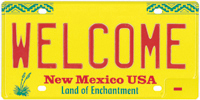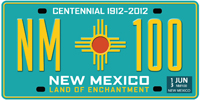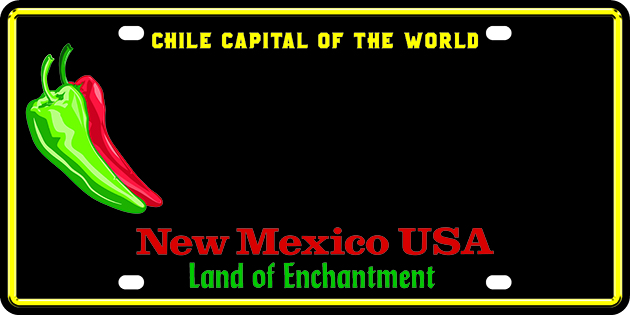Section A. Documents Required to Title and Register a New Vehicle
Section B. Issuance of License Plate and Validation Sticker
Section A: Documents Required to Title and Register a New Vehicle
Revised October 12, 2018
- Manufacturer’s Certificate of Origin (MCO) (§§ 66-3-4(C) and 66-3-118)All new vehicles built by a manufacturer are identified by the issuance of a Manufacturer’s Certificate of Origin (MCO), sometimes also called a Manufacturer’s Statement of Origin or MSO. All MCOs must be original documents issued by the manufacturer. Photocopies will not be accepted. If the original is lost, stolen or mutilated it is possible that the manufacturer will issue a duplicate MCO.The MCO must show:
a. Complete descriptive information of the vehicle;
b. Complete assignment from the manufacturer to a franchised dealer (an MCO assigned to a non-franchised New Mexico dealer must first be converted to a New Mexico Title before the non-franchised dealer can negotiate the MCO);
c. The purchaser’s information as assigned from the franchised dealer to the first purchaser of the vehicle.An MCO may be accepted without notarization of the assignment if the Motor Vehicle Division in the state of origin does not require notarization. If the assignment and reassignment field have a certification statement and a place for notarization, do not reject if assignment is not notarized.
- Purchase Agreement/Dealer’s InvoiceThe purchase agreement or dealer’s invoice is required on every title transaction involving a dealer sale, including purchases from out-of-state dealers. The purchase agreement or dealer’s invoice must be the original or a certified copy. This document is essential for the computations of the excise tax, based upon the net sale price of the vehicle. A non-certified copy will be accepted if the sale price conforms to the NADA Retail Pricing Index Guide (i.e. is at least 80% of the N.A.D.A. new car/truck MSRP value of the vehicle). However, if any taxes are paid out-of-state a certified copy of the purchase agreement or dealer’s invoice must be provided.The purchase agreement or dealer’s invoice must show the following:
- Date
- Customer’s name
- A description of the vehicle including year, make, and VIN;
- A description of any trade-in vehicle including VIN;
- The gross sales price before trade-in deduction, if any;
- The net sales price less any discounts;
- If taxes are paid to an out-of-state dealer.
NOTE: An “Intent to Purchase” document cannot be accepted as a purchase agreement or dealer’s invoice.
- Odometer Statement (§§ 66-3-4, 66-3-10, 66-3-101(A), 66-3-107(C) and 49 CFR 580.5)Federal and state law require that the transferor of a motor vehicle attest to the accuracy of the odometer mileage reading at the time of the vehicle’s sale, transfer or assignment. The odometer mileage statement can be attested to in the assignment on the back of the MCO, on MVD Form 10187 “Odometer Mileage Statement” or on MVD Form 10002 “Application for Title and Registration.” Odometer mileage disclosure statements may be accepted provided that they conform to federal standards, i.e. they must have language stating that mileage is actual (AM), exceeds mechanical limits (EL), warning odometer discrepancy (NM), or exempt (EX). The odometer statement is required on all motor vehicle title transactions, except off-highway vehicles.
- Proof of Trade-In Vehicle
A copy of a trade-in vehicle’s registration or Certificate of Title is no longer required. Tapestry only requires the trade-in vehicle’s VIN from the sales invoice.
- Affirmation of Insurance (§§ 66-5-234, 66-5-233 and 66-5-208)
Every applicant for a vehicle registration must affirm that he is financially responsible within the meaning of the Mandatory Financial Responsibility Act (MFRA). Payment of the registration fee and acceptance by the department of the application for registration shall be affirmation by the owner of the registered vehicle that they have complied with the requirements of that act. If the applicant affirms the existence of a motor vehicle insurance policy, they must provide the name of the insurer issuing the policy, the state where the policy was issued, the policy number, and the issue and expiration dates.
“Financial responsibility” as used in the MFRA, means the ability to respond in damages for liability on account of vehicle accidents in the following amounts: $25,000 for bodily injury to or death of one person in any one accident; $50,000 for bodily injury to or death of two or more persons in any one accident; and $10,000 for injury to or destruction of property of others in any one accident.
- Power of Attorney (POA)
General or Limited:
a. Must be notarized;
b. Owner must sign in ink;
c. Certified copies of POA may be accepted;
d. If notary’s commission expires, POA remains active until rescinded by owner;
e. POA cannot be used to execute any transaction after death of grantor;
f. Dealers MUST use a secure POA ONLY;
g. Proof of ID for Owner’s Representative (Motor Vehicle photo ID card or license).
NOTE: A Person appointed with a Power of Attorney CANNOT assign their authority by Power of Attorney to another individual.
- Lien Holder Information
Lien holder information is required to be complete upon application for title and registration. Applications lacking any of the following information may be rejected and returned to the applicant for completion:
a. the lien file and maturity date;
b. the lien holder’s name and mailing address.
Missing information can be obtained without mailing all paperwork back, if an authorized agent for the lien holder is able to submit the completed application by fax or email.
- New Mexico Residence Address Required (§66-3-4(A))Individual owner/applicants for title and registration must provide the owner’s name and bona fide New Mexico residence address and mailing address. Acceptable proof of New Mexico residence address can be either: a) a current New Mexico driver’s license (DL) or regular identification card (ID); or b) the same two documents that would be required to prove residency for a Real ID driver’s license or identification card, as specified in the Drivers Manual Chapter 6 Section A. If the DL/ID address and the registration address are not the same, two documents will be required as proof of residency for the vehicle registration.When there are multiple owners, at least one owner must be a bona fide resident of New Mexico. Proof of identity and New Mexico residency is only required for that one owner, who should be listed as the first individual owner on the vehicle’s registration and who is the only owner who can use the vehicle registration as proof of the owner’s New Mexico residence address. For this purpose it makes no difference whether the joint ownership designation is recorded as “and” or “or.”
Similar documentation shall be required of any applicant for vehicle registration and certificate of title that is a firm, association, corporation or other entity (non-individual) owner and is not an established MVD customer. In addition to the specific examples (such as utility bill, insurance bill or bank statement) listed in the Drivers Manual Chapter 6 Section A, acceptable documents to prove New Mexico business address for an entity owner would include a business license, articles of incorporation or equivalent documents.
Reject the application if the applicant does not have a New Mexico residence or business and mailing address.
Exception: §66-3-301(E) requires that a nonresident doing business in New Mexico and owning and regularly operating a vehicle here shall register the vehicle. If the nonresident business does have a bona fide New Mexico business address, the same documentation is required as for any other entity owner. However, it is sometimes the case that a nonresident business, in order to comply with §66-3-301(E), wants to register a vehicle in New Mexico but has no New Mexico business address. In that case, the requirement of a bona fide New Mexico business address does not apply, and we will accept the owner’s out-of-state business address for our records.
As always, any documents used to prove a vehicle owner’s New Mexico residence or business address must include that residence or business address.
Exception: (see Chapter 15 Section A – RVs): A non-resident who takes possession of an RV in New Mexico may register the RV in New Mexico, with no proof of NM residency required. However, proof of delivery in New Mexico is required.
Exception: (see Chapter 8 Section A), Vehicles transferred to Nonresidents (§66-3-10): Whenever a vehicle owner transfers the vehicle to a nonresident who desires to title the vehicle in the state of his residence, the division upon receiving application and the payment of the proper fee shall issue a certificate of title only and record on the certificate all liens and encumbrances.
- Title Application and Owner’s SignatureWhen a lien holder, dealer or title company is submitting the title work for an applicant, a completely filled out Title Application must be included. The owner or the authorized representative must sign, in ink, on the Title Application. If multiple owners names are joined with “AND”, then both/all signatures are required. If a representative is signing for the applicant, a notarized power of attorney is required. An officer of a company may sign the Application for Title without a Power of Attorney.
- Notice of Additional RequirementsWhile processing Vehicle related transactions in Tapestry, if ANY of the required documents are missing, you must prepare and generate MVD Form 10282 “Notice of Additional Requirements for completion of Vehicle Transaction.” Tapestry will generate this letter to document all requirements that have been met and especially to document everything that is missing or incorrect. Customer Service Representatives can include additional notations to the letter to ensure that customers are notified of everything they will need to have for a successful outcome on their next visit. Key-entered additional notations will also be visible to all other users from the CRM tab.When reviewing all the documents submitted by the applicant(s), keep in mind that transactions should be rejected if documents lack any necessary information, do not have all signatures, or are incorrect or missing information. Any discrepancies found shall be explained to the applicant. Be sure to review the documents carefully and note all additional requirements necessary to complete the transaction. Generate the “Notice of Additional Requirements for Completion of Vehicle Transaction” letter, give it to the applicant and advise them that all required documents must be returned within 10 days of the date on the form to avoid late registration penalties and late transfer fees. Tapestry will allow a Manager override if it is determined later that the 10 day period should be extended.
Reject the transaction if there are any erasures, alterations, type-overs or discrepancies on any of the documents. To the extent possible, documents should have the same typeset, ink, etc., to avoid being reviewed by staff as an alteration.
Section B: Issuance of License Plate and Validation Sticker
Revised December 1, 2017
- Issuance of Registration Plate (§66-3-14)Issue a new registration plate to every new vehicle being titled for the first time, except in those cases when the applicant has a plate previously issued to them, for the same class of vehicle, that they want to transfer to the new vehicle (see paragraph 4 below).
- Replacement Plate (§66-3-17)The person to whom the plate is issued may, at any time, apply for the issuance of a duplicate or replacement plate.
- Registration Plates Issued by Vehicle TypeIssue registration plates to new vehicles according to the type of vehicle. Passenger vehicles, trucks and farm trucks have the option to register with the yellow, turquoise or chile plate



- Transferring Owner’s Previous Plate to New Vehicle (§66-3-101(B))
The owner of a registered vehicle sold or traded-in on a new vehicle is responsible for removing the registration plate from the vehicle sold or traded-in. The owner may then apply to have the plate and the registration number assigned to another newly acquired vehicle of the same class.
The clerk must be able to verify by computer that the plate belongs to the applicant or the applicant must provide proof (copy of registration or title).
- Issuing Validation Sticker
A validating sticker must be affixed to the registration plate registered to a new vehicle at the time of registration. Exceptions: manufactured homes and freight trailers are not issued validating stickers.
A vehicle registered into the staggered registration program shall be issued a year/month sticker showing the month in which the vehicle is originally registered and the year of expiration.
- Vehicles with different plate and/or sticker requirements
Off-highway motor vehicles (OHVs) are issued registration stickers. Registration is for two (2) years. An OHV may also be issued a permanent on-highway registration sticker (see Chapter 16 Section F) if the OHV’s owner intends to operate an off-highway motor vehicle on paved streets or highways in accordance with the provisions of the Off-Highway Motor Vehicle Act.
Utility trailers and travel trailers with a gross vehicle weight (GVW) under 6,001 lbs. and not used in commerce may be registered permanently. Issue a permanent registration sticker.
Other utility trailers and travel trailers (i.e. those that are used in commerce or have a GVW of 6,001 lbs. or more) may only be registered for one or two years.
Commercial vehicles driven exclusively on New Mexico highways (intrastate) are issued a Weight Distance (WD) plate with a validating sticker.
Commercial Vehicles that operate in other states as well as New Mexico (interstate) are registered through the International Registration Plan (IRP). These vehicles are registered on a staggered basis with the expiration consistent for all units in a fleet. IRP registrations are processed by the Commercial Vehicles Bureau (CVB).
